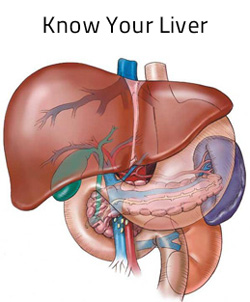
What’s so great about it?
Your liver is for life. You have only one and though it is unique in its ability to regenerate, it can only survive limited damage – so it does need looking after.
What is its position?
Place your right hand over the area under your ribs on the right side of your body and it will just about cover the area of the liver. The liver is the largest gland and solid organ in the body, weighing some 1.8 kg in a men and 1.3 kg in women. It holds approximately 13 per cent (about one pint or 0.57 litres) of the total blood supply at any given moment, and it has over 500 estimated functions.
What does it look like?
The liver is dark reddish brown in colour and is divided into two main lobes (the much larger right and the smaller left), which are further subdivided into approximately 100,000 lobules. About 60 per cent of the liver is made up of liver cells (hepatocytes), and each of these has an average lifespan of 150 days. In every milligram of liver tissue there are approximately 202,000 cells. Two-thirds of the body of the liver is the parenchyma, which contains the hepatocytes, and the remainder is the biliary tract. The liver receives its blood supply via the hepatic artery and portal vein which transports nutrients from the intestine (gut). The liver and biliary tract
The biliary tract contains the right and left hepatic ducts, which meet to form the common hepatic duct. This is joined by the cystic duct from the gall bladder, which then forms the common bile duct. The common bile duct joins the intestine at the duodenum through a valve called the Sphinter of Oddi.
The gall bladder is a pear-shaped bag 9 cm long with a capacity of about 50 ml. Breakdown products, such as bile salts, bilirubin, cholesterol, phospholipids, proteins, electrolytes and water, are secreted by hepatocytes, and they are eventually transported down the bile ducts (this is bile and it is modified by cholangiocytes lining the bile ducts). The gall bladder stores bile, a greenish-yellow coloured liquid, which is delivered during a meal into the gut to assist with the breakdown (emulsifying) of fat in the food digested to allow easier absorption of fat and vitamins A, D, E and K. The liver produces approximately one pint (or 0.57 litres) of bile a day.
What is its role?
The liver is a complex chemical factory that works 24 hours a day. Virtually all the blood returning from the intestinal tract to the heart passes through the liver. This means everything you swallow that is absorbed into the bloodstream passes through the liver.
The liver functions can be divided into four basic categories:
Regulation, Synthesis and Secretion